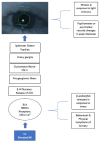Using Pupillometry to Assess the Atypical Pupillary Light Reflex and LC-NE System in ASD
- PMID: 30469373
- PMCID: PMC6262612
- DOI: 10.3390/bs8110108
Using Pupillometry to Assess the Atypical Pupillary Light Reflex and LC-NE System in ASD
Abstract
With recent advances in technology, there has been growing interest in use of eye-tracking and pupillometry to assess the visual pathway in autism spectrum disorder (ASD). Within emerging literature, an atypical pupillary light reflex (PLR) has been documented, holding potential for use as a clinical screening biomarker for ASD. This review outlines dominant theories of neuropathology associated with ASD and integrates underlying neuroscience associated with the atypical PLR through a reciprocal model of brainstem involvement and cortical underconnectivity. This review draws from animal models of ASD demonstrating disruption of cranial motor nuclei and brain imaging studies examining arousal and the influence of the locus coeruleus norepinephrine (LC-NE) system on the pupillary response. Pupillometry methods are explained in relation to existing data examining the PLR in ASD and pupillary parameters of constriction latency and tonic pupil diameter as key parameters for investigation. This focused review provides preliminary data toward future work developing pupillometry metrics and offers direction for studies aimed at rigorous study replication using pupillometry with the ASD population. Experimental conditions and testing protocol for capturing pupil parameters with this clinical population are discussed to promote clinical research and translational application.
Keywords: autism; biomarker; eye tracking; locus coeruleus; pupillary light reflex; screening.
Conflict of interest statement
The authors declare no conflicts of interest.
Figures



References
-
- Kanner L. Autistic Disturbances of Affective Contact. 1943. pp. 217–250. [Publisher not identified] - PubMed
-
- American Psychiatric Association . Diagnostic and Statistical Manual of Mental Disorders: DSM-5. 5th ed. American Psychiatric Association Publishing; Washington, DC, USA: 2013.
Publication types
LinkOut - more resources
Full Text Sources

